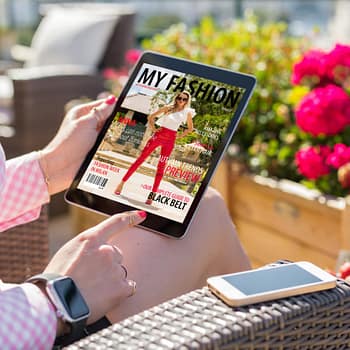5 Types of Fashion Photography Used in Ecommerce
Retail e-commerce is big business in the UK, with 41.1 million apparel e-commerce users in the country and online sales set to account for more than US$39.9 billion by 2025. With so much competition out there, online retailers need to ensure that their products and clothing are showcased in fashion photographs the right way, making sure you catch the eye of your target demographic. And that means investing in the right type of commercial photography. Here’s some insight into what fashion photography is all about and the most common styles of photography used by e-commerce retailers.
What is fashion photography?
If you’re an e-commerce retailer, you already know that having a strong visual impact is essential if you want to properly showcase your products and draw in customers. Fashion photography is about helping customers visualise themselves in your clothing, to inspire them to try new fashion trends, and inform them about the look, style, and feel of your clothing. These fashion images are what makes the description and design come alive for the consumer, allowing them to envision themselves in your outfit and showing them that it’s the right item they want to buy.
Types of Fashion Photography
Because photographing clothing is about sending such important information to the potential customer, it’s a far less simple task than many people realise. The different types of fashion photography styles influence how an item is showcased, the message it sends to the customer, and how well it appeals to your target market. Here’s some insight from industry-leading fashion photographers to help you find the type of fashion photography that’s the perfect fit.
1. Editorial photography
Fashion editorials are designed to create context around an outfit, fitting it into a narrative. This is commonly used in fashion magazines, where brands and fashion photographers work around a theme to develop a story that a consumer can place themselves within. This means that props, special effects, accessories, locations or backdrops, and different items are used to make the entire page come to life.
The theme can be as simple as a season (for example, spring) or as targeted as a specific event or cultural activity to promote alternative fashion (for example, skateboarding or music festivals). It can be an obvious setting or a much more subtle and mysterious feel that intrigues the customer, so it can be tailored to your brand’s vision and the factors that appeal most to your target market. This helps inspire consumers who connect with the theme to place themselves in the story that you are selling and buy the item because it speaks to them on a personal level.
In terms of online use, this technique is usually used on a brand’s main pages rather than the e-commerce pages, setting the tone for the type of clothing, message and values a consumer can expect. It’s all about creating a mood that suits a particular brand, range, or label, helping customers make that all-important personal connection with that item of clothing or outfit.
2. Catalogue Fashion Photography
Catalogue fashion photography is focused on the product or item of clothing itself, usually setting it against subtle or plain backgrounds with little detail to visually distract the viewer. This style of photography is linked back to clothing catalogues themselves, where you’d flip through a physical printout of a clothing brochure and send off an order.
It’s simple, clear, and unfussy with a minimalist approach to make the outfit or item of clothing the star of the show. This makes it very similar to product or even food photography, where you want a clear item for the customer to focus on rather than sweeping them up in a dramatic situation or vision.
For these shoots, fashion photographers won’t use props, special effects, accessories, or anything else that will distract from the item. The model will often move into various poses to showcase particular features of the clothing like pockets, ties, hoods, or straps, and the finished result is usually a few different images that are set together to show the front and back of the item as well as a close up of the material itself.
This is often called the simplest type of fashion photography – but that doesn’t mean it’s easy. Because they are so simple and straightforward, tiny differences in movement, background, lighting or pose can make or break these images.
For this reason, this is the most popular style of photography for e-commerce websites. It makes the item easy for consumers to see and evaluate, and it conforms with standards for e-commerce giants like Amazon, who require white backgrounds for products.
3. Street Fashion Photography
While editorials tend to focus on a strong fantasy or trend, street photography is about keeping everything real and down-to-earth, making it the perfect fit for urban fashion and alternative fashion. It often features real people rather than models, photographing them (with permission) in real, everyday situations – although with an artistic flair, of course! The focus here isn’t just on the clothes – it’s the entire situation, from their expression and the natural light to their confidence and body language.
Good examples of this include sports brands that showcase everyday athletes running on their street or working out in the park, grunge brands on motorbikes or in vintage cars, and stylish teens expressing their creative outlook as they practice on musical instruments. It usually focuses on different subcultures that you’d find in a vibrant and diverse city, like skaters, grunge, hipsters, hip hop, vintage or thrift, and culturally-inspired aesthetics.
This is a great trend for e-commerce photography when you have an urban fashion brand because it puts your clothing into everyday life. Consumers are more easily able to translate this into their own lives, making trends seem more achievable and applicable to their lifestyle.
4. Lookbook Fashion Photography
A lookbook is similar to catalogue fashion photography except that it tries to give outfits and clothing more context. You can think of it as a mix between catalogue and street photography in many ways because while the focus is still on the clothing, the setting is real life rather than a plain white background.
This is a great option for brands that offer items that shine in different situations or suit certain lifestyles or aspirations. Typical examples would be a swimsuit shoot on a beach or near a pool, contextualising comfortable loungewear with an overstuffed couch or warm cup of hot chocolate, or a sportswear shoot with yoga props and weights.
This style of fashion photography is a type of comfortable middle ground for e-commerce retailers that want their clothing to stand out without becoming too targeted to a specific demographic or so plain that they get lost in the crowd.
5. High Fashion Photography
This is the most elite and exclusive fashion photography style, with fashion photographers pushing the boundaries of their art. High fashion is about glamour, drama, and creating a deep and lasting impact. It’s utilised by the world’s leading fashion brands in magazines and online to showcase how their brand is impacting the world of fashion, and it’s what you typically see on the cover of Vogue, Elle, or Vanity Fair from fashion houses like Gucci, Burberry, Chanel, and Armani. This type of fashion photography is usually used for a dedicated campaign where months of work by specialists in marketing, design, and fashion has gone into developing a concept that will bring these outfits to life in a very distinctive and impactful way.
Typically, high fashion photography is about being thoughtful, creative, and innovative, often using exaggerated poses, unrealistic situations, creative hair and makeup, and dramatic lighting. By using cutting-edge photographic techniques, uniquely talented models, exotic or statement locations, and bespoke clothing, these photographers create a distinct mood and style to deliver a very specific aesthetic for what the brand wants to tell the world.
Inspire, connect and stand out through world-class eCommerce fashion photography
Marca Fashion Photography studio specialises in photography styles for e-commerce retailers, bringing the experience of your clothing and outfits to your customer through online technology.
With a reputation for excellence and a track record working with top London and global fashion brands, we deliver bespoke fashion photography that delivers the results your brand deserves. We work with e-commerce businesses of every size on campaigns with every budget, and our professional photographers have delivered successful campaigns to industry-leading fashion brands including Lacoste, Emporio Armani, Hugo Boss, Puma, Adidas, and more.




